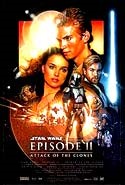The Decade’s Steady Stream of Box-Office Blockbusters and Sequels
The decade spawned many new blockbuster series (or franchises), sequels, serials, or reboots, often featuring comic-book superheroes, fantastical tales (based on previous novels by Tolkien, J.K. Rowling, and C.S. Lewis), CGI-animated characters, or action-thrillers. It could easily be said that some of the biggest films of the decade were based on adaptations of previous artistic works:

Many of these huge money-making franchise-blockbusters were the top-grossing films of their individual years in the decade:
- 2000: How the Grinch Stole Christmas
- 2001: Harry Potter and the Sorcerer’s Stone
- 2002: Spider-Man
- 2003: The Lord of the Rings: The Return of the King
- 2004: Shrek 2
- 2005: Star Wars Episode III: Revenge of the Sith
- 2006: Pirates of the Caribbean: Dead Man’s Chest
- 2007: Spider-Man 3
- 2008: The Dark Knight
- 2009: Avatar
Technological and Special Effects Innovations of the Decade:
2001: director Pitof’s dark 19th century crime fantasy Vidocq (2001) was the world’s first-completed theatrical feature film shot entirely on Hi-Def digital video.
WATCH: opening scene of Vidocq

George Lucas’ second Star Wars pre-quel, Star Wars: Episode II – Attack of the Clones (2002), the fifth film in the hugely successful Star Wars series, was the first big-budget major Hollywood film shot entirely with digital video cameras (at 24 fps) – best screened in theaters equipped with digital projectors.
Sky Captain and the World of Tomorrow (2004) was shot entirely without physical sets against a green screen with very photo-realistic, all-CGI backgrounds and live actors. Human actors were completely filmed in front of a green/blue screen with no background sets at all.
Trailer for Sky Captain and the World of Tomorrow
Sky Captain and the World of Tomorrow trailer – CC
Director Peter Jackson’s King Kong (2005) the largest number of special/visual effects shots in a single film, surpassing the previous records set by Star Wars Episode III: Revenge of the Sith (2005), and Jackson’s own trilogy of The Lord of the Rings films. The more than 3,200 final shots in the film were culled from 3 million feet of live-action footage and 2,510 visual effects shots.
Visual Effects: The Technique of Performance Capture
Performance capture (or motion capture) became more widespread and sophisticated as a special effects technique in the 2000s.
Performance capture referred to a digital blend of live performance and animated elements. Actors wore heavy, dot-sensor-covered spandex body suits and a helmet, and initially acted out their scenes in isolation from other sets, props, costumes, or actors. Expressions and movements were first recorded by digital cameras as 3D “moving data points” – and afterwards, the digitally recorded performances were translated and embellished by key-frame artists and integrated into an exclusively virtual environment.
WATCH: Gollum in The Lord of the Rings: The Two Towers (2002)
- Robert Zemeckis experimented with the technology in his own The Polar Express (2004); in his next film, Beowulf (2007) — was released simultaneously in standard 2-D and non-Imax 3D versions and had the biggest 3-D rollout of any film in history (to date)
- Director Zack Snyder’s Watchmen (2009) featured the photo-realistic, all-CGI character of the all-powerful, blue-glowing “atomized” scientist Dr. Manhattan (Billy Crudup) which was also created with the process of motion capture
WATCH: Watchmen clip
https://youtu.be/efx_DNUQkX0
- James Cameron’s ambitious, monumental animated/live-action fantasy Avatar (2009), his first feature film since Titanic (1997), was a futuristic, epic 3-D film with ground-breaking special effects involving performance capture.
WATCH: Filming Motion Capture
